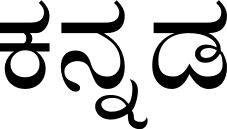Difference between revisions of "Language/Kannada/Grammar/Pronouns"
m (Quick edit) |
m (Quick edit) |
||
| Line 54: | Line 54: | ||
===Parts of Speech Part 2 - Pronoun | Explained in Kannada. - YouTube=== | ===Parts of Speech Part 2 - Pronoun | Explained in Kannada. - YouTube=== | ||
<youtube>https://www.youtube.com/watch?v=_XoeuNJx4HU</youtube> | <youtube>https://www.youtube.com/watch?v=_XoeuNJx4HU</youtube> | ||
==Related Lessons== | |||
* [[Language/Kannada/Grammar/Future-Tense|Future Tense]] | |||
* [[Language/Kannada/Grammar/Adjectives|Adjectives]] | |||
* [[Language/Kannada/Grammar/Gender|Gender]] | |||
* [[Language/Kannada/Grammar/Questions|Questions]] | |||
* [[Language/Kannada/Grammar/Conditional-Mood|Conditional Mood]] | |||
* [[Language/Kannada/Grammar/Negation|Negation]] | |||
* [[Language/Kannada/Grammar/Nouns|Nouns]] | |||
{{Kannada-Page-Bottom}} | {{Kannada-Page-Bottom}} | ||
Revision as of 23:04, 25 February 2023
Hi Kannada learners! 😊
In today's lesson, we will be discussing Kannada pronouns. Pronouns are an important part of the Kannada language and understanding them is essential for speaking and writing correctly. We will look at the different types of pronouns, how they are used, and some examples of their usage.
Types of Pronouns
Pronouns can be divided into two main categories: personal pronouns and demonstrative pronouns.
Personal Pronouns
Personal pronouns are used to refer to people or things. They include the following:
- ನನ್ನ (nanna) - I/me
- ನಿಮ್ಮ (nimma) - you
- ಅವರು (avaru) - he/she/they
- ಅವರುಗಳು (avarugalu) - they
These pronouns can be used in both singular and plural forms. For example, ನನ್ನ (nanna) can be used to refer to one person, while ನಿಮ್ಮಗಳು (nimmagalu) can be used to refer to multiple people.
Demonstrative Pronouns
Demonstrative pronouns are used to point out specific people or things. They include the following:
- ಈದು (eedu) - this
- ಅದು (adu) - that
- ಈಗಾಗಲು (eegaagalu) - these
- ಅಗಾಗಲು (agaagalu) - those
These pronouns can also be used in both singular and plural forms. For example, ಈದು (eedu) can be used to refer to one thing, while ಈಗಾಗಲು (eegaagalu) can be used to refer to multiple things.
Usage
Pronouns are used in a variety of ways in Kannada. They can be used to refer to people or things, to make comparisons, and to ask questions.
For example, ನಿಮ್ಮ (nimma) can be used to refer to a person, ಅದು (adu) can be used to compare two things, and ನಿಮ್ಮನ್ನು (nimmanne) can be used to ask a question.
It is important to note that the gender of the pronoun must match the gender of the person or thing being referred to. For example, ಅವರು (avaru) should be used when referring to a male, and ಅವರುಗಳು (avarugalu) should be used when referring to multiple males.
Examples
Here are some examples of how pronouns can be used in Kannada:
- ನನ್ನ ಹೆಸರು ಶ್ರೀಮಂತ (Nanna hesaru shreemanta) - My name is Shreemanta.
- ನಿಮ್ಮ ಹೆಸರು ಎಂದು? (Nimma hesaru endu?) - What is your name?
- ಈದು ಅದುವುದು ಹೆಚ್ಚು ಹೆಚ್ಚು ಹೆಚ್ಚು (Eedu aduvudu hecchu hecchu hecchu) - This is bigger than that.
- ಅಗಾಗಲು ಅವರುಗಳು ಹೆಸರು ಎಂದು? (Agaagalu avarugalu hesaru endu?) - What are their names?
If you have any questions, please ask them in the comments section below.
Feel free to edit this wiki page if you think it can be improved. 😎
Videos
Pronouns and Vibhakti in Kannada - YouTube
Parts of Speech Part 2 - Pronoun | Explained in Kannada. - YouTube
Related Lessons
